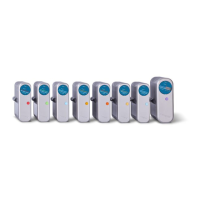PNEUMATIC CONTROL FUNDAMENTALS
ENGINEERING MANUAL OF AUTOMATIC CONTROL
71
Controllers may also be classified as single-pressure or two-
pressure controllers. Single-pressure controllers use a constant
main air pressure. Two-pressure controllers use a main air
pressure that is alternately switched between two pressures,
such as 90 and 124 kPa. For example, occupied/unoccupied
controllers automatically change setpoint from a occupied
setting at a mainline pressure of 90 kPa to a lowered unoccupied
setting at 124 kPa. Heating/cooling controllers change from
reverse acting at mainline air pressure of 90 kPa for cooling to
direct acting at 124 kPa for heating.
TEMPERATURE CONTROLLERS
Temperature controllers can be one- or two-pipe. The sensing
element is typically bimetal, liquid filled remote bulb, or liquid
filled averaging capillary tube. Dimensional change of the
element with temperature change results in flapper position
change and therefore, pilot and branch pressure change.
HUMIDITY CONTROLLERS
Principles that apply to temperature controllers also apply
to humidity controllers. The primary difference between
temperature and humidity controllers is in the type of sensing
element. The sensing element in a humidistat is usually a band
of moisture-sensitive nylon. The nylon expands and contracts
with changes in the relative humidity of the air.
The humidistat can be used in a one-pipe or two-pipe
configuration and is available as either a bleed-type humidistat
or a two-pipe capacity humidistat using a capacity amplifier.
The humidistat may be direct or reverse acting. The high-
capacity humidistat has a capacity amplifier.
PRESSURE CONTROLLERS
Pressure controllers can be divided into two classes according
to the pressure range of the measured variable. High-pressure
controllers measure and control high pressures or vacuums
measured in kilopascals or pascals (e.g., steam or water
pressures in an air conditioning system). Low-pressure
controllers measure and control low pressures and vacuums
measured in kilopascals or pascals (e.g., pressure in an air duct).
High- and low-pressure controllers have different size
diaphragms. In both types, one side of the diaphragm is
connected to the pressure to be controlled, and the other side is
connected to a reference pressure. Pressures can be measured
in respect to atmospheric pressure or another pressure source.
The low-pressure controller is available in both bleed-type and
pilot-bleed designs.
Figure 20 shows a schematic of a bleed-type, low-pressure
controller. The direct-acting pressure sensor measures static
pressure from a pressure pickup located in a duct. A reference
pressure, from a pickup located outside the duct, is applied to
the other side of the diaphragm.
PRESSURE SENSOR
REFERENCE
PRESSURE
STATIC
PRESSURE
C2609
SETPOINT
SPRING
DIAPHRAGM
M
BRANCH
FEEDBACK
BELLOWS
MAIN LEVER
Fig. 20. Bleed-Type Static Pressure Controller.
On an increase in static pressure, the increased force on the
diaphragm exceeds the force of the setpoint spring, pulling the
main lever downward. A setpoint adjustment screw determines
the tension of the setpoint spring. As the main lever is pulled
downward, it moves closer to the nozzle, restricts the airflow
through the nozzle, and increases the pressure in the branch.
The action continues until the pressure on the feedback bellows
balances the static pressure on the diaphragm.
On a decrease in static pressure, or if the static pressure
sensor is piped for reverse action (high- and low-pressure
pickups reversed), the diaphragm moves upward to move the
main lever away from the nozzle and reduce the pressure in the
branch.
For differential pressure sensing, the two pressure pickup
lines connect to opposite sides of the pressure sensor diaphragm.

